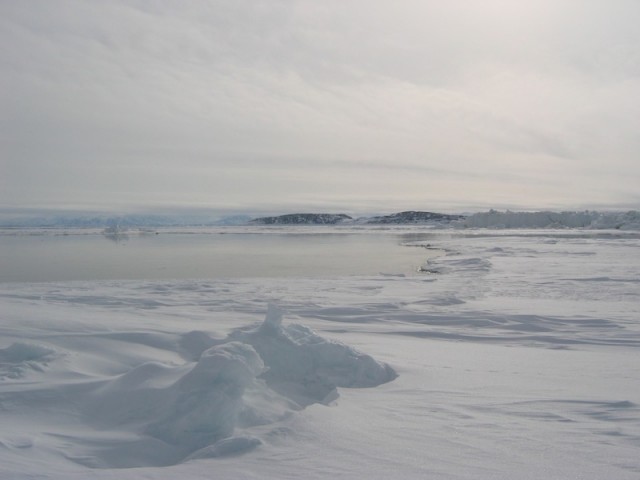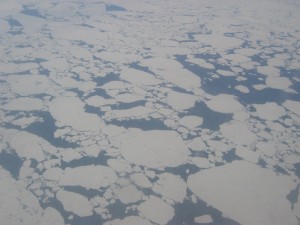Inuit can no longer rely on Arctic ice
One of the most noticeable effects of global warming is the large-scale melt of sea ice in the Arctic. Simon Nattaq, an Inuit hunter, experienced the effects of climate change in a tragic way. The ice is no longer the same, he says in Nunavut’s capital Iqaluit.
By Frank Kuin in Iqaluit
Simon Nattaq could always rely on the quality of the Arctic ice. As a teenage boy, the 61-year-old Inuk man learned to hunt in the vicinity of the remote hamlet of Hall Beach (Inuk is singular for Inuit, the indigenous people of Canada’s Arctic). His family was still living a nomadic life, and his father taught him where to find Arctic foxes, caribou and seals – and how to get to those places over frozen bays.
So Nattaq knew exactly what kind of ice you could expect in the seasons named by the Inuit, including Ukiaq (early winter), Ukiuq (winter), and Upinqasaak (early spring). Traditional knowledge held that somewhere between Ukiaq and Ukiuq the main freeze would occur, in which the ice acquired a solid thickness for the entire season, and a white hue. A substantial layer of snow isolated the firm ice from sunlight.

Sea ice and open water in Nunavut.
These days, all that is different, says Nattaq in his home in Iqaluit, the capital of Canada’s semi-autonomous Nunavut territory. “The ice no longer reaches the same thickness and doesn’t have the same colour as before,” he says. “There is more blue in it. The snow is thinner and blows away. During the spring melt, there are normally puddles on the ice. Now, that water drains away because there are small holes in the ice. It freezes differently, not as solid.”
Nattaq experienced the change in ice conditions in a traumatic way. During a hunting expedition in February 2001, he fell through the ice with his snowmobile. He managed to pull himself out of the freezing cold water, but lost all his possessions. He sought shelter, and was found two days later by concerned friends. Both his feet were frozen and had to be amputated. Nattaq now has two prosthetic lower legs, and walks with difficulty. He blames his painful fate on climate change.

Ice floes in Nunavut. The Arctic sea ice is melting due to global warming,
“The ice was white on top, and that always meant that it was safe,” says Nattaq. “But because it melted from below, it only seemed that way. It has become more difficult and riskier for our hunters to move across the ice, as we have done for centuries. Even the most experienced hunters with the most thorough knowledge encounter problems. Climate change has major implications for our mobility, our way of life.”
Melting polar ice is widely recognized as one of the most noticeable effects of global warming. Scientific research has consistently shown that the average surface area of sea ice in the Arctic Ocean has steadily declined over the past decades. A new study from the National Snow and Ice Data Center in Colorado showed this month that the northern ice cap is melting even faster than previously thought. According to the researchers, the Arctic may be completely free of sea ice in summer as early as the second half of this century.
For the Inuit, the consequences of the thaw exceed changes in the weather. The Arctic ice is the basis of their traditional existence. For most of the year, it is a source of food, as well as a means of transportation:
The disappearance of that world is seen by the Inuit as a threat to their traditional culture, which is already under pressure from southern influences. Within a few generations, the Inuit have gone from an existence as nomadic hunters to a life in settled communities with supermarkets and satellite TV.
“We have more material things than before, but life is more chaotic,” says Nattaq, seated at the table in a kitchen with a microwave. His wife is watching a cartoon on TV with one of their grandchildren; in the corner of the room, there’s a computer with a webcam. “We are living like the qallunaat (white people), but we’re missing what we need the most,” he says. “In the past, the Inuit had their own unique way of living.”
Older members of the Inuit population are trying to teach that way of life to the youth, as a moral compass. By teaching them the traditional survival techniques of the Inuit, such as hunting, a sense of identity and self-respect should be instilled in them, to guide them through a rapidly changing world. Simon Nattaq fears that climate change will only increase the advent of southern culture in Nunavut. “The climate is becoming more southern, more and more people from the south come here.”
Meanwhile, hunters like himself have to adapt to the new conditions when they go out, by coordinating with each other and looking out for one another. Such cooperation is also needed on an international basis to combat climate change, he says. “People from around the world have to come together to ensure that the environment remains as natural as possible,” he concludes. “That takes cooperation.”
This post is also available in: Dutch
Categories
- The North
- Atlantic provinces
- Quebec
- Ontario
- Prairie provinces
- British Columbia
- Canada in the world
- Canada & the Netherlands
- Canada & the US
- First Nations and Inuit
- Immigration and multiculturalism
- Politics
- Justice
- Defence
- Economy
- Sports
- Health
- Arts and culture
- Canadian identity
- Environment and nature
- Science
- Travel
- History
- Religion
More about:
- Oil
- Climate change
- Shell
- Stephen Harper
- Dutch in Canada
- Tar sands
- Immigrants
- Arctic
- Afghanistan
- Integration
- Mining
- Armed Forces
- Natural Resources
- Canada - U.S. border
- BlackBerry
- Protests
- Barack Obama
- Liberation of Holland
- Haida Gwaii
- Drones
- Ottawa attack
- Justin Trudeau
- Wildlife
- Keystone XL
- Lac-Mégantic
- Railways
- War on Terror
- Vancouver 2010
- Refugees
- Marijuana
- Indian Residential Schools
- Hockey
- Jean Charest
- Alaska
- Downtown Eastside
- Amanda Todd
- Luka Rocco Magnotta
- Kandahar
- Khadr Family
- Michael Ignatieff



 Nederlands
Nederlands  English
English 
